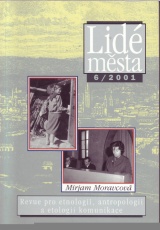Hudba na ulici města
DOI:
https://doi.org/10.14712/12128112.4137Abstrakt
The study is based on the reality of a Iong-standing and continuous presence of musicians and singers in city streets. This may be music for promenades, performed in city parks by amateur, semi-professional as well as professional bands (as a rule, their repertory included concert overtures, waltz, popular compositions and tunes), or a music of amateur, often handicapped musicians, students, but also semi-professional musicians who look for places suitable for music performance in order to receive a financial reward. ln socialist Czechoslovakia under the totalitarian regime the street music all but vanished and only revived in the new political circumstances after November 1989. A research conducted in 1998 with the involvement of students from the university in Passau focused on three European big cities - Vienna, Munich and Prague. lt worked by means of the method of shared observation and the questionnaire method. The research eventually led to the determination of ten basic circles of observation: 1. the used musical instruments; 2. the phenomenon of the place; 3. the causes of the street playing from the viewpoint of the musician; 4. profit; 5. the personality of the performer; 6. the elements of distinctiveness of the musician, his props; 7. repertory and quality of performance; 8. competition; 9. organisation of the performance; 10. audience. The research showed a stability of this cultural and social phenomenon and its integration into the organism of the city. lts substance has not changed in comparison with the past in any substantial way; it links what is pleasant and useful. For the money voluntarily given to the musicians the city residents and visitors are provided with a cultural product whose quality is not always an absolute condition of the existence of street music. Unlike the past the singers do not need to move the listeners with heartbreaking stories. If anything, the tourists mostly do not understand the lyrics, and the singing and music are perceived as a pleasant animation of the streets of the cities' pedestrian zones, as a counter-balancing spiritual, though sometimes somewhat naive, artistic element among the depersonalised stylised dummies behind the shopwindows. There is a novelty in the form of the use of sound technologies of tape recorders which have replaced the sound of street organs in their original, but actually a different purpose serving, cabinets. Moreover, they are being used for a playback background for singing or instrumental playing. The street musicians often do not rely only on the reward for their playing or singing, bul they strongly increase their earning through the sale of easily accesible recordings of their own performance. The musician goes to extreme lengths to attract the attention of passers-by. For this he uses a number of props if he is not conspicuous with his being handicapped. The repertory and quality of the performance are not the most important guarantees of successfulness of the street playing. There is a whole range of factors the musician is well aware of and takes advantage of them skilfully. The audience in the cities accepts the street playing in a positive way and this, along with its practical social meaning, is very likely to ensure its existence even in the future.
Stahování
Publikováno
Jak citovat
Číslo
Sekce
Licence

Tato práce je licencována pod Mezinárodní licencí Creative Commons Attribution-NonCommercial-NoDerivatives 4.0.


